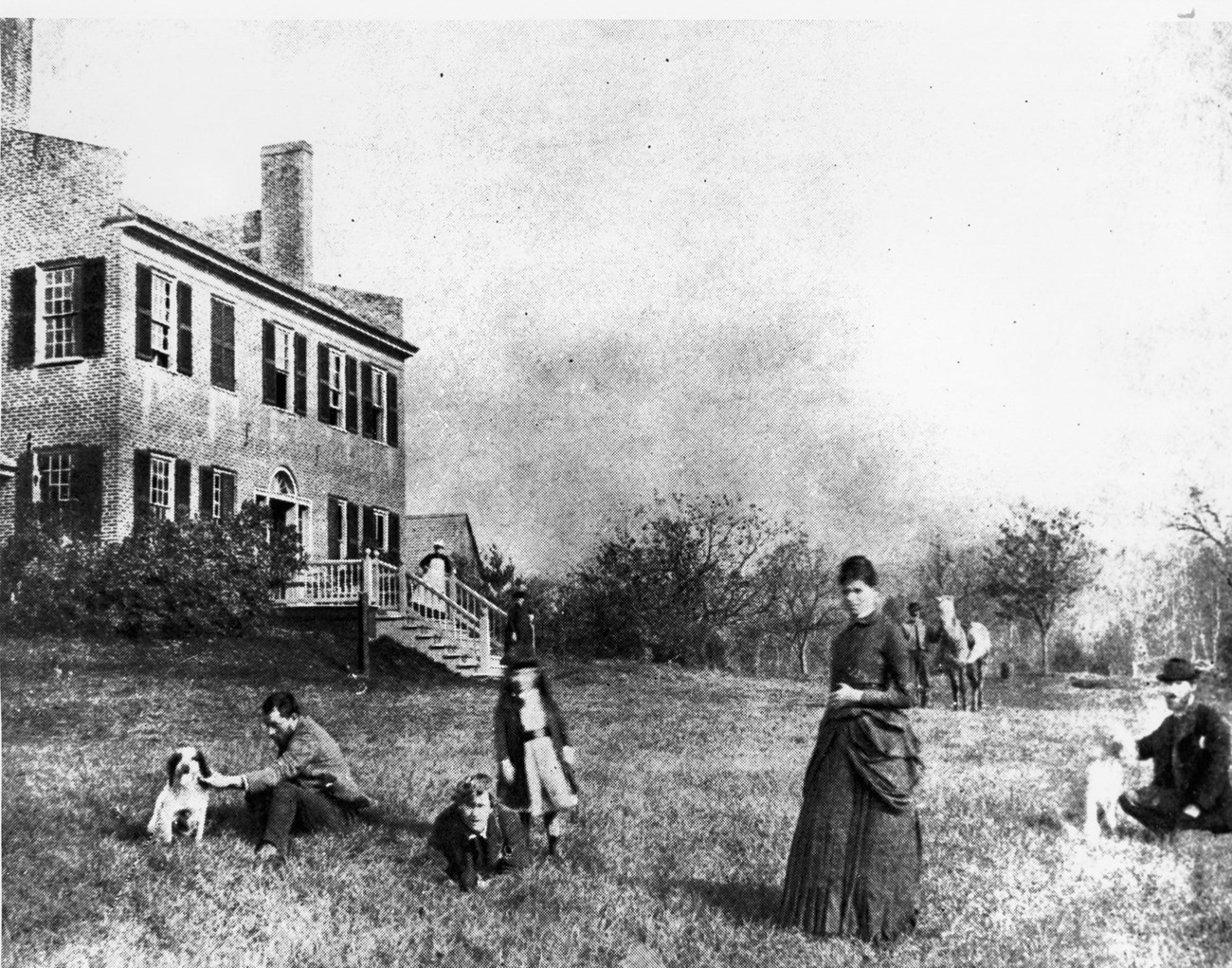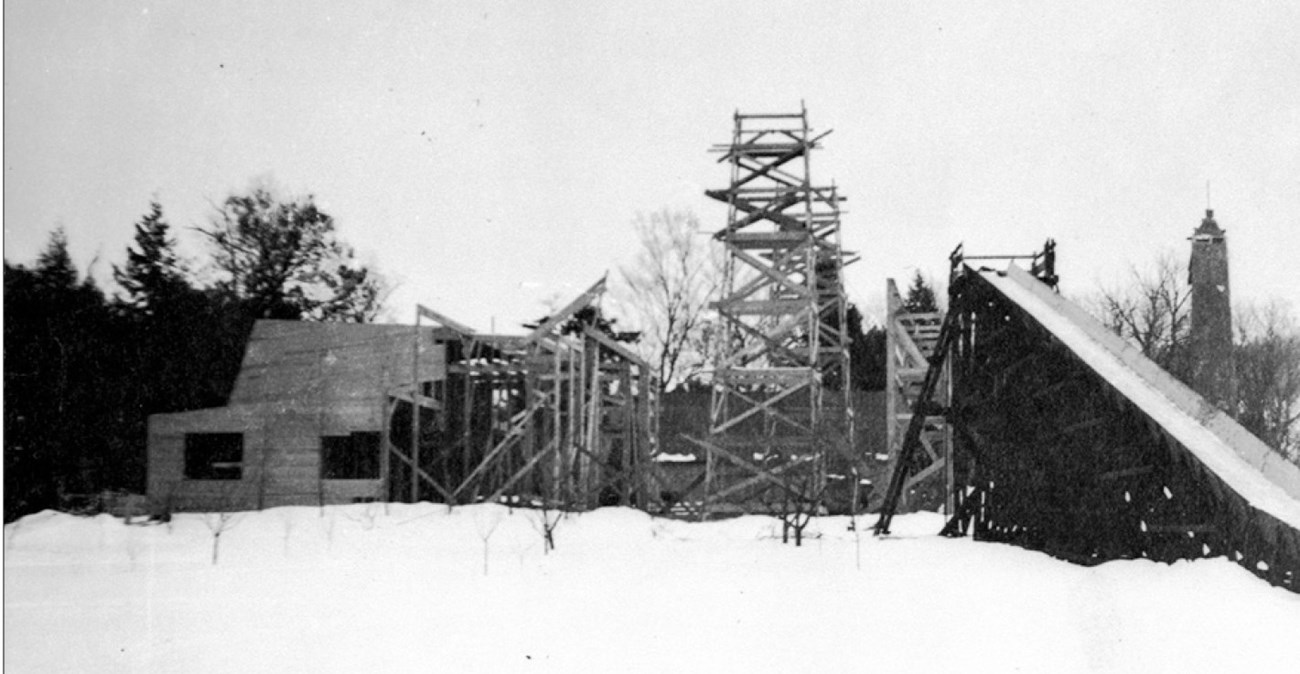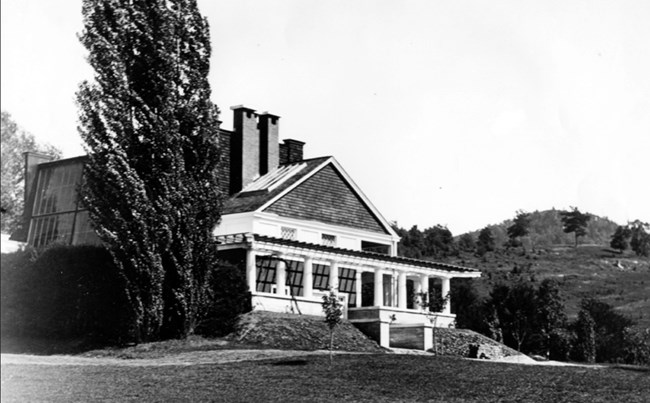Last updated: April 18, 2023
Article
The Apple Trees at Aspet

Carol Highsmith, Library of Congress
Introduction
Saint-Gaudens National Historical Park preserves the home, studios, artwork, gardens, and fruit trees of Augustus Saint-Gaudens, one of the foremost American sculptors of the late nineteenth and early twentieth centuries. The home and studios are surrounded by terraces and garden rooms, walled by hedges and ornamented with sculptures. Overlooking the Connecticut River in Cornish, New Hampshire, these designed features of the landscape reflect the artistry of Saint-Gaudens and other Cornish Colony artists.
Other features of the landscape reflect utilitarian and recreational activities, which were also important in the lives of Saint-Gaudens and other artists. Saint-Gaudens found pleasure in sculpting, shaping, and interacting with the landscape. The sculptor and his wife, Augusta, entertained their many friends in their home and on the landscape, including a group of Saint-Gauden’s assistants and protégés. The fruit trees were part of the beauty of the landscape and also provided bounty for the table.
Landscape History
Sheep grazing and wool production increased in New Hampshire during the early 1800s, and the area’s productive soils and suitable mill sites prompted development. Walter Mercer, a successful woolen mill owner and farmer, moved to Cornish in 1829 and acquired the home known as “Huggins’ Folly”. The house, built in 1817 by brothers Samuel and Jonas Huggins, was part of a 134-acre property that consisted of two acres of orchard, pasture, arable land, and wild areas. By 1840, the town had grown to just over 1700 residents. As agriculture declined in New Hampshire in the late 1800s, the number of vacant farms increased. The state attempted to market farms to immigrants was more successful in attracting city residents for summer use.

NPS / Saint-Gaudens National Historical Park (SAGA 859)
Walter Mercer sold the Mercer-Huggins farm to lawyer Charles Beaman in 1884. In the summer of 1885, Saint-Gaudens rented the property from his friend, Beaman, and moved into the Federal style brick house with his wife, Augusta, and young son, Homer. He set up a studio in the adjacent hay barn and they returned to Cornish each summer, making minor improvements before purchasing the property in 1891. Saint-Gaudens renamed the property “Aspet” after the town in France where his father was born. When the Saint-Gaudens first arrived, much of the rolling local landscape was deforested from agricultural activities, accentuating the expansive views of the bucolic, rural countryside and Mount Ascutney across the Connecticut River. The rustic property and surrounding farm landscape appealed to the Saint-Gaudens. Augusta had grown up in Roxbury, Massachusetts and was drawn to the prospect of gardens, orchards, and raising farm animals. At that time, the Roxbury area was also known for orchards, and it is believed that Augusta’s family either owned an orchard or were near one. It is possible that she could have brought trees from Roxbury to plant at Aspet, although further research would be needed to confirm that the same varieties of trees were grown in each location. Augustus was born in Dublin, Ireland and raised in New York City with periods as a student in Paris and Rome. He found the idea of a home and studio in the country attractive, and the particular features of Aspet were favorable.

NPS
Art in the Landscape
The landscape development that occurred during the Saint-Gaudens’ occupation illustrates both his appreciation for art and aesthetics and his pleasure in the rural setting. Soon after they occupied the property, Saint-Gaudens began to modify the house and landscape to incorporate classical, formal elements, largely inspired by his time in Europe. Saint-Gaudens created a terraced flower garden with complex and geometric beds of annuals and perennials. Hedges helped define outdoor rooms, focusing the eye along the length of the geometric features.
Some of the construction was later described as the activity of a man who delighted in the working, reworking, and shaping of his surroundings, taken up in the spirit of continual improvement rather than out of necessity. Homer Saint-Gaudens expressed this characteristic of his father in 1913, stating, "There was hardly a week in all the time my father spent on this place during twenty-two years that he did not have something rebuilt or regarded to his intense enjoyment."
Recreation and Enjoyment
In addition to shaping the formal landscape elements, the Saint-Gaudens also maintained a vegetable garden, fruit trees, and golf course, demonstrating the multiple purposes of the landscape. The golf course was a five green, nine-hole course and was one of the earliest irrigated golf course in the country. Saint-Gaudens and his assistants also swam during their summer work breaks. A swimming pool (otherwise known as the plunge pool) was first constructed behind the Hay Barn Studio in the mid-1890s, attached to the building on a flat terrace. While the pool was later filled in, the outline is visible on the ground behind the Little Studio. The Blow-Me-Up Brook was dammed to create a separate swimming hole in the ravine below Aspet in the late 1800s. In the winter, Saint-Gaudens skated on the nearby ponds and constructed massive, multi-story toboggan runs.

NPS / Saint-Gaudens National Historical Park (SAGA 881a)
After a cancer diagnosis in 1900, Saint-Gaudens recuperated from surgery at Aspet, which he had decided to make his year-round home. He was determined to alter his lifestyle to include more fresh air, outdoor activity, and recreation, as means of both improving his health and enhancing his enjoyment of life.
"For my first winter in Cornish, I was deeply impressed and delighted by its exhilaration and brilliancy, its unexpected joyousness, the sleigh-riding, the skating and what not. I was happy as a child. I threw myself into northern life and reveled in it.”
The property was already equipped for both informal and formal recreation, but he now began to use those facilities with greater enthusiasm. He told his staff, “Play, play! I wish I played more when I was young. I took things too seriously.”
As his health deteriorated, Saint-Gaudens transitioned from active recreation opportunities, like swimming and golf, to more passive activities like enjoying the natural scenery and artistry of the gardens until his passing in 1907. With the establishment of the Saint-Gaudens Memorial in 1919, Augusta began to present his art and open the studios, caring for the site and its legacy until her death in 1926. The Saint-Gaudens Memorial continued to operate the property as a museum until 1964 with the transfer of the estate to the National Park Service. Saint-Gaudens National Historical Park has become a highly visited memorial for its collection of galleries, sculptures, and gardens.
Agriculture and Apple Trees
The rural and agricultural character of Cornish defined the area, alluring both historical residents and contemporary visitors. Apple trees are one example of how the surrounding landscape was reflected at Aspet. They do not appear to be a part of the formal landscape plan created by the Saint-Gaudens, yet they contributed to both its aesthetic and functional value.
The Apple Trees at Aspet Today
The site has been documented and recognized as a significant historic resource for many years. The property was first designated as a National Historic Landmark in 1962. President Lyndon B. Johnson signed legislation to authorize the creation of the Saint-Gaudens National Historic Site in 1964. Saint-Gaudens National Historic Site (now Saint-Gaudens National Historical Park) was officially established in 1965, when requirements of the legislation were met and the Saint-Gaudens Memorial donated the property–including all structures, land, and artworks–to the federal government for public ownership.

NPS / Saint-Gaudens National Historical Park (SAGA 808)
Three groupings of apple trees are located in the historic core: to the east of the entry walk, to the west of the entry walk, and to the west of the Little Studio. These groupings are visible in early photographs and recorded on the French and Bryant survey completed in December 1903. The earliest photographs of the Saint-Gaudens family at Aspet, taken in the summer of 1885, show that a grouping of apple trees was already growing southeast of the house. The row to the west of the Little Studio consisted of six trees ranging from one to two inches in diameter, suggesting that these were planted by Saint-Gaudens. They planted a larger orchard of apple, cherry, and plum trees west of what is now the New Gallery complex, which was removed by the 1920s.
Many of the trees were lost some time between 1926 and 1965. In the 1970s and 1980s, the park replanted the missing trees using the 1903 survey as a reference. There is no documentation on the apple tree varieties present during the historic period, but the park has identified several varieties with assistance of the Geneva Agricultural Experiment Station at Cornell University, Cooperative Extension at University of New Hampshire, Burford Brothers Nursery in Virginia, and Washington State University Horticulture Department.
With the expertise of these partners and through genetic testing of the trees, one apple tree at Aspet was revealed to be a non-identifiable variety, meaning that its DNA is not in the National Clonal Germplasm Repository. This makes it unique part of this landscape and a benefit to those seeking other apple tree information, such as the DNA of heirloom varieties around New England, information about dissemination of trees across the country, and the lineage of trees that gave rise to early varieties.
Apple Tree Varieties
The third volume of the Cultural Landscape Report for Saint-Gaudens National Historic Site, published in 2013, documents treatment of the cultural landscape and lists the apple trees that had been identified. Tree numbers in the tables are adopted from the Cultural Landscape Report, Volume III and correspond to the labels in the small images.
Trees West of Little Studio

NPS
|
Variety |
Planted |
Details |
Tree Number |
|---|---|---|---|
|
McIntosh Apple (Malus sp.) |
Origin of tree is unknown |
Species needs to be verified |
20 |
|
‘Wolf River’ (Malus sp.) |
Original tree replaced in 1997 |
Original apple tree of unknown cultivar |
21 |
|
Red Canada Apple (Malus ‘Red Canada’) |
Origin of tree is unknown |
Tentative identification in 1994 by the Cornelll University New York State Agricultural Experiment Station in Geneva, New York. Variety introduced in 1822, originated in New England, also known as Nonsuch and Steele’s Winter Red. Species needs to be verified. |
22 |
|
‘Red Astrachan’ aka ‘Abe Lincoln’ Apple (Malus sp.) |
Origin of tree is unknown |
Propagated by the Olmsted Center for Landscape Preservation. Identified in 2008 by William Lord at University of New Hampshire and by Tom Burford. |
23 |
|
‘Macoun’ Apple (Malus sp.) |
Origin of tree is unknown |
Species needs to be verified |
24 |
|
Yellow Transparent Apple (Malus ‘Yellow Transparent’) |
Original tree replaced in 1997 |
Identified by park staff, replaced with purchased nursery stock |
25 |
Trees East of Entry Walk

NPS
|
Variety |
Planted |
Details |
Tree Number |
|---|---|---|---|
|
Idared Apple (Malus ‘Idared’) |
Circa 1972, NPS |
Identified in 2022 by Cameron Peace (WSU) |
8 |
|
Macoun Apple (Malus sp.) |
1984, NPS |
Species needs to be verified |
9 |
|
Macoun Apple (Malus 'Macoun') |
1984, NPS |
Identified in 2022 by Cameron Peace (WSU) |
10 |
|
Cortland Apple (Malus sp.) |
Circa 1972, NPS |
Identified in 1994 by the Cornell University New York State Agricultural Experiment Station in Geneva, New York |
11 |
|
Cortland Apple (Malus sp.) |
Over 100 years old |
Species needs to be verified, needs to be propagated |
12 |
|
Fameuse Apple (Malus sp.) |
Over 100 years old |
Propagated by the Olmsted Center for Landscape Preservation. Identified in 1994 by the Cornell University New York State Agricultural Experiment Station in Geneva, New York |
13 |
Trees West of Entry Walk

NPS
|
Variety |
Planted |
Details |
Tree Number |
|---|---|---|---|
|
Cortland Apple (Malus sp.) |
Circa 1972, NPS |
|
14 |
|
Macoun Apple (Malus sp.) |
Circa 1972, NPS |
Identified in 2009 by William Lord, Cooperative Extension at University of New Hampshire |
15 |
|
Common Apple (Malus sp.) |
Over 100 years old |
Propagated by the Olmsted Center for Landscape Preservation. No ID able to be confirmed after DNA testing in 2022. |
16 |
|
Common Apple (Malus sp.) |
Circa 1972, NPS |
Died and removed 2002, needs to be replanted. |
17 |
|
McIntosh Apple (Malus sp.) |
1972 or 1984, NPS |
Identified in 1994 as ‘Jewett Red’ by the Cornell University New York State Agricultural Experiment Station in Geneva, New York; as ‘McIntosh’ by William Lord at the University of New Hampshire; and ‘Northern Spy’ by Tom Burford. ID confirmed in 2022 as 'McIntosh' by Cameron Peace (WSU) |
18 |
|
Chinese Pearleaf Crabapple (Malus prunifolia var. rinkii) |
Original tree replaced in 1997 with propagated cutting |
|
19 |
Recently, the park has grown ten grafts from scionwood taken from the remaining apple trees, five from the Fameuse and five from the unknown variety. Park horticultural staff are working with a local orchardist for care of the grafts until they are ready to be replanted.
As Saint-Gaudens developed his home at Aspet, he found pleasure in the landscape through recreational activities, sculpting and shaping its built and natural features, and maintaining the rural character and function that defined the Cornish area farms. The apple trees were a part of this appeal, some already growing and others that they planted. Today, the NPS continues to care for the trees as a significant part of the landscape.
The park's historic varieties of apple trees link Aspet to the agricultural history of Cornish and are also a reminder that many fruit tree varieties are not naturally occurring. They are the product of a history of breeding and only continue to exist if they are cared for and perpetuated. At least one apple tree at Aspet is a previously unknown heirloom variety.
The Cultural Landscape Report for Aspet documents this history and significance of the landscape and provides a guide for treatment of features as part of the landscape, including the apple trees. It recommends replacing trees that are lost with varieties that date to the historic period, and propagating replacement plants from existing trees.
Further Reading
-
Saint-Gaudens National Historic Site Cultural Landscape Report, Volume I (1993)
-
Aspet: Saint-Gaudens National Historic Site, Cultural Landscape Report, Volume II (2009)
-
Aspet: Saint-Gaudens National Historic Site, Cultural Landscape Report, Volume III, Treatment & Record of Treatment (2013)
-
Saint-Gaudens National Historic Site Landscape Cultural Landscape Inventory (2013)





